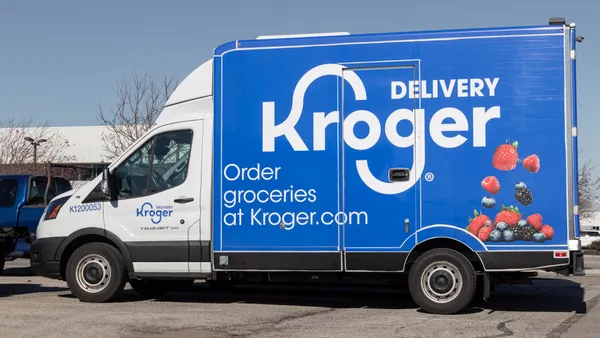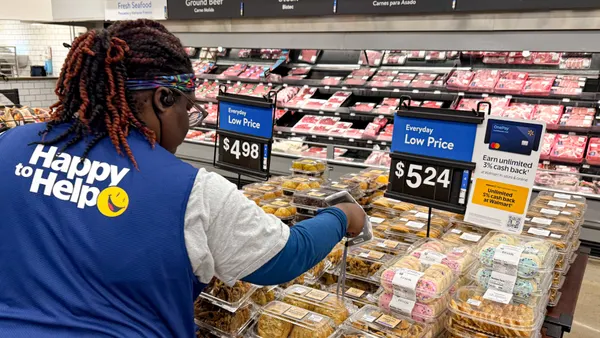Dive Brief:
- Blue Apron reported a loss of $5.3 million in the first quarter of fiscal 2019, down from a loss of $31.7 million during the same period last year, according to a company release. The meal kit company reported adjusted EBITDA of $8.6 million, more than double its goal of $3.4 million, making it Blue Apron’s first reported profit since its IPO in 2017.
- However, the company’s orders dropped 29% to 2.5 million along with its customer count, which stands at 550,000, down from 786,000 a year ago. Sales also plunged to $141.9 million from $196.7 million the year prior. Average revenue per customer increased from $250 to $258. Shares were down 1.46% Tuesday morning.
- During the company's earnings call, Tim Bensley, CFO of Blue Apron said it will discontinue its same-day delivery pilot in New York City through Grubhub and launch delivery through its own platform in the San Francisco Bay Area. Customers go directly to the Blue Apron site and order any of the two-person offerings, which he says will likely be priced at a slight premium. If orders are placed before noon, they’ll be delivered between 4 and 6 p.m.
Dive Insight:
Blue Apron is laboring to shore up its business as sales and customer count plummet and experts whisper of an acquisition. But the company’s new CEO, former Etsy executive Linda Koslowski, may revive the business by optimizing operations and honing in on its most valuable consumers.
“While we knew this focus would result in lower revenue in the near term, this deliberate decision was centered around our conviction that strengthening our customer base and driving toward profitability are critical steps to building a healthy and sustainable business," Bensley said during Tuesday's earnings call.
As Koslowski transitioned to the CEO role and former CEO Brad Dickerson stepped away, the company continued to trim losses as it pulls back on marketing spend — the culprit in many meal kit providers’ inability to reach profitability. Companies like Chef’d have shut down its business while others like Albertsons’ Plated have scaled back operations.
“My priorities coming into the organization are two-fold: Establish a differentiated customer strategy and build off of a foundation that I believe is now in place to return the business to growth," Koslowski said during Tuesday's call.
The foundation Koslowski notes is the company’s recent growth and efficiency strategies, including its same-day delivery roll out in the Bay Area, its expansion of its Knick Knack products on Jet.com and its partnership with WW, which shows Blue Apron customers' preference for healthy offerings, Bensley said. As the traditional subscription model continues to struggle, Blue Apron and other meal kit companies will continue to explore new channels and creative partnerships.
Blue Apron's same-day delivery service in San Francisco isn't going to be as speedy as its Grubhub partnership, which whisked meal kits to customers in as little as an hour. But executives say the move will produce better margins and a more unified brand experience. The Bay Area is a sweet spot for meal kit lovers, and Blue Apron will hope waiting a few hours to receive delivery won't be a deal breaker for them.
Blue Apron has made significant progress towards fixing a leaky ship. But eventually the company will have to return to growth mode, and that seems anything but assured at this point. Koslowski’s track record at e-commerce giants Etsy and Alibaba bode well for the company. However, she faces an uphill battle against a challenging economic model and competition from retailers, restaurants and a host of e-commerce food players.










